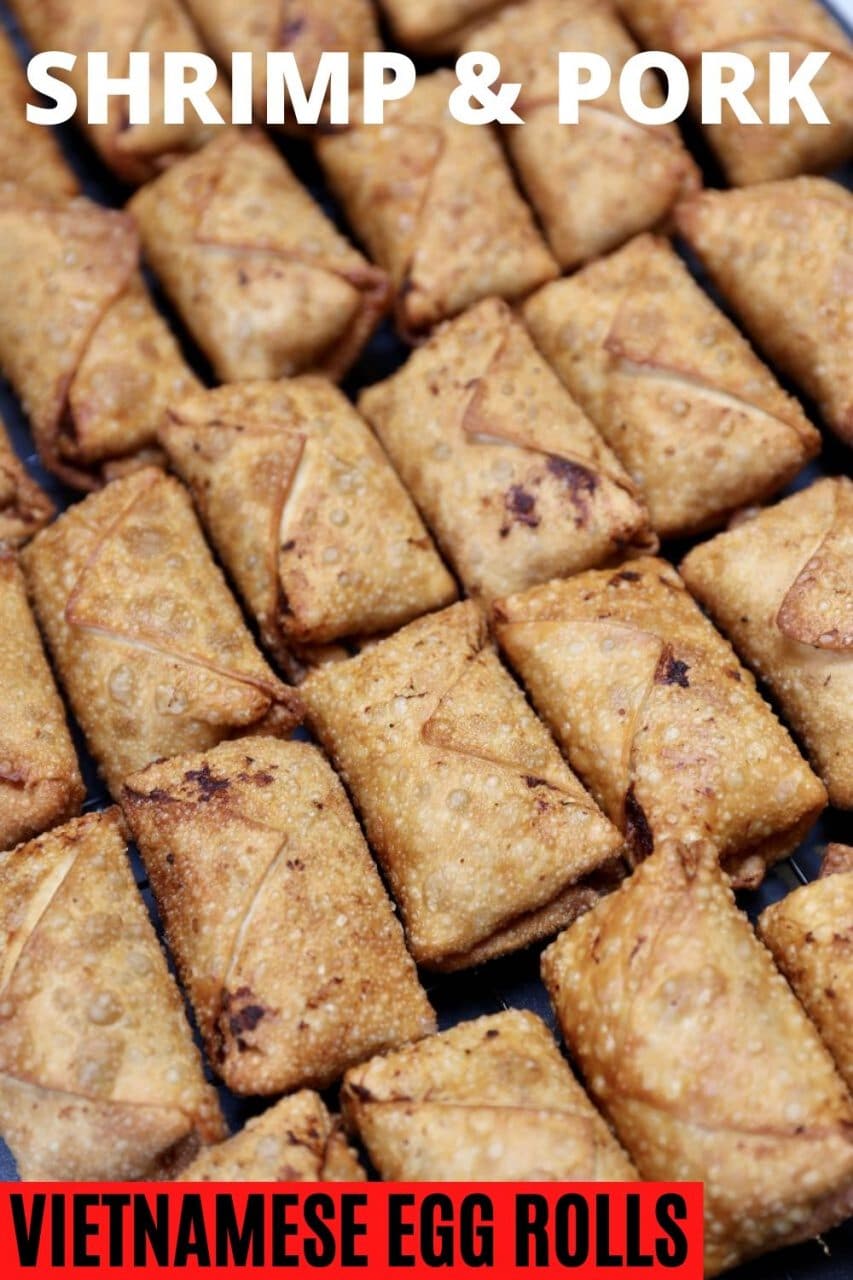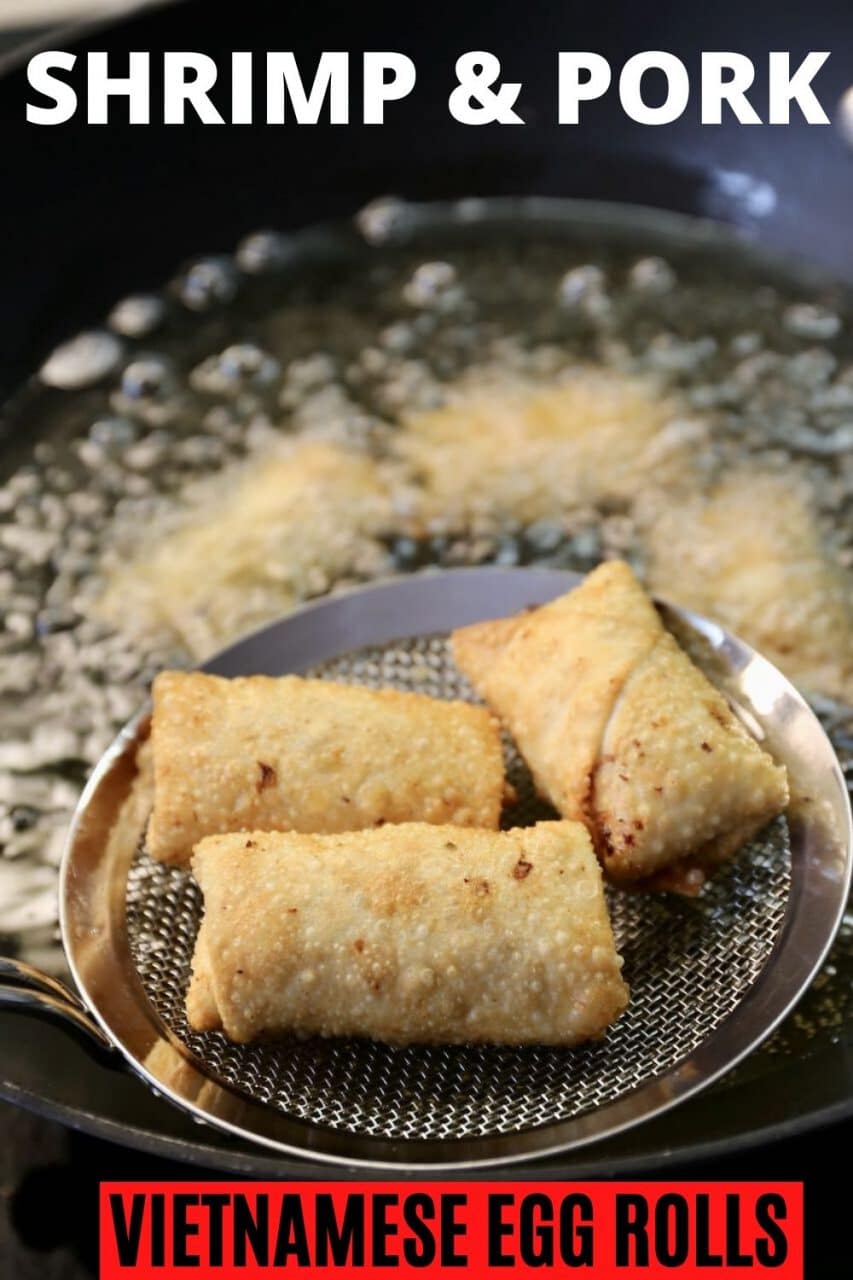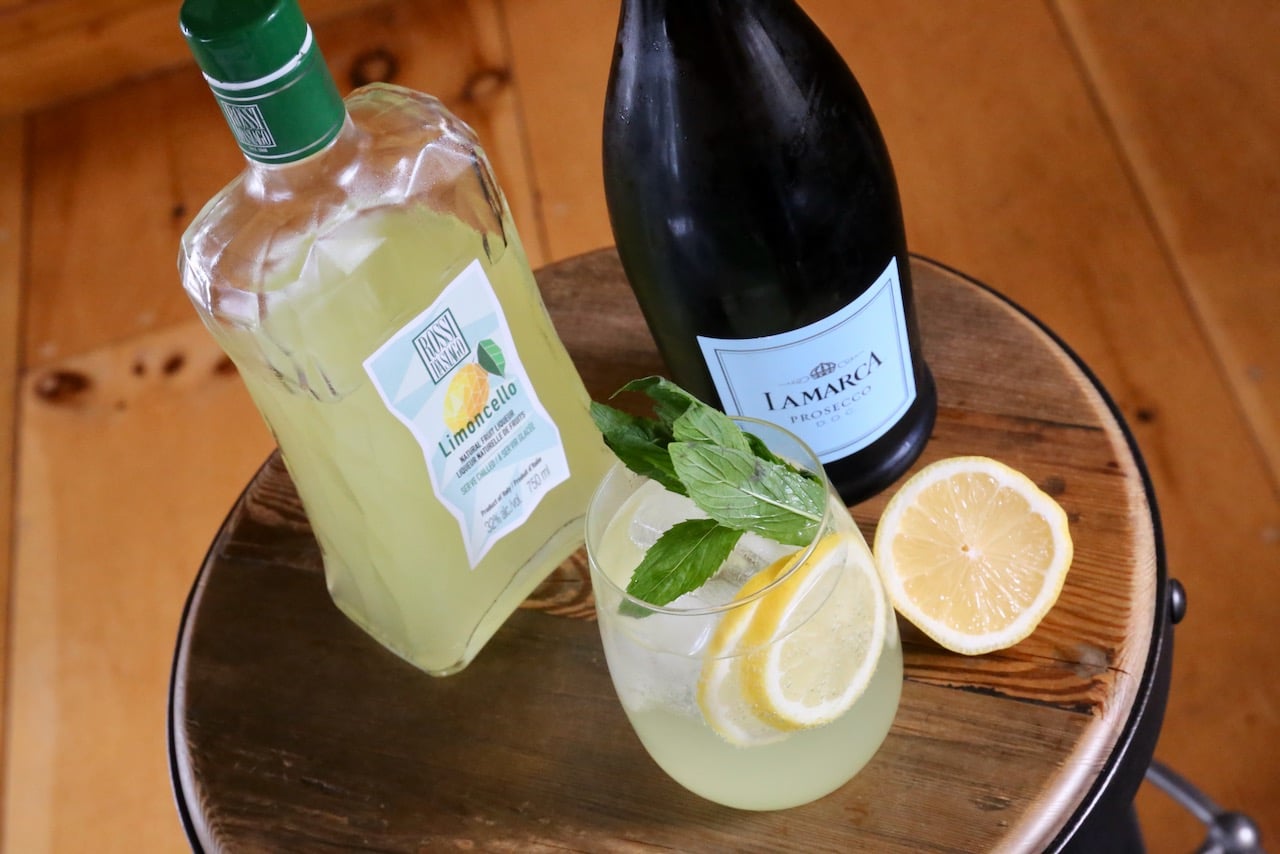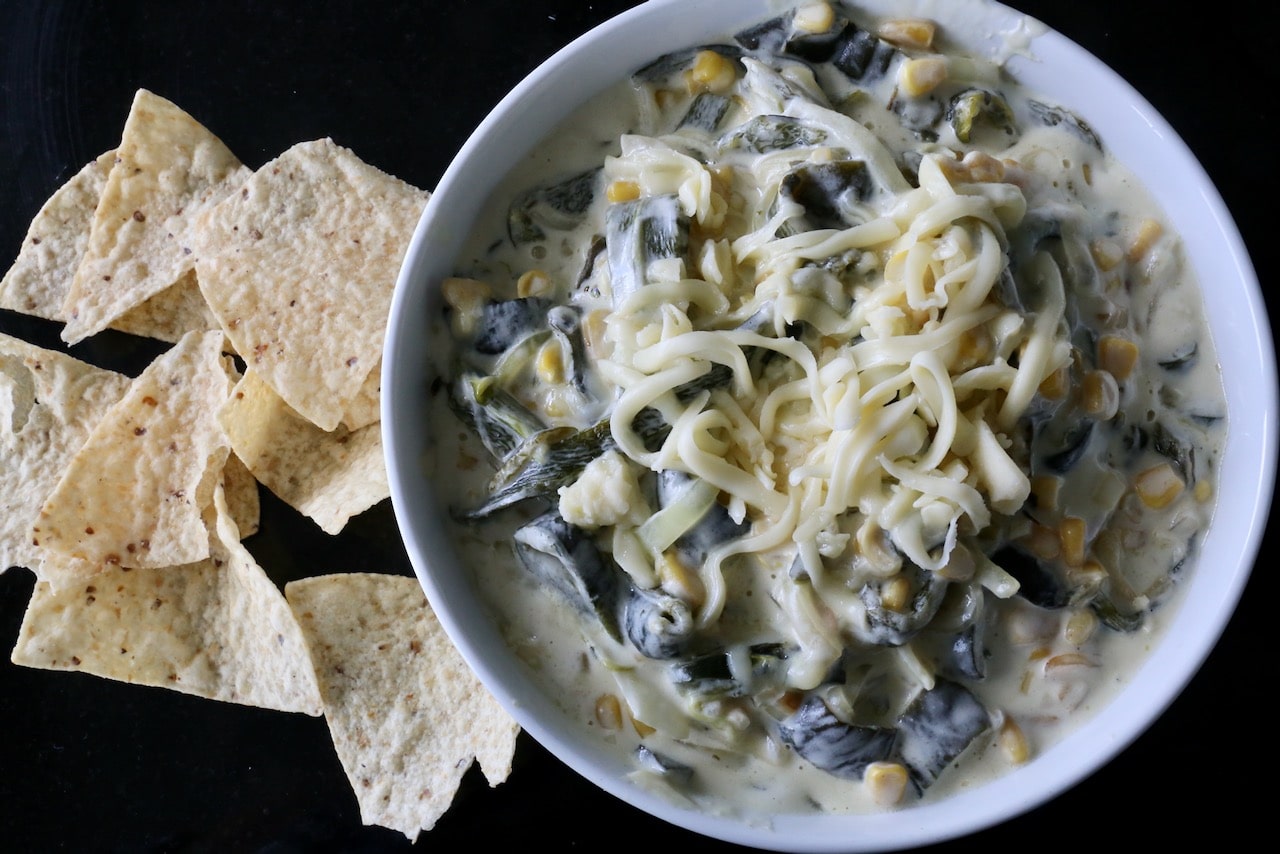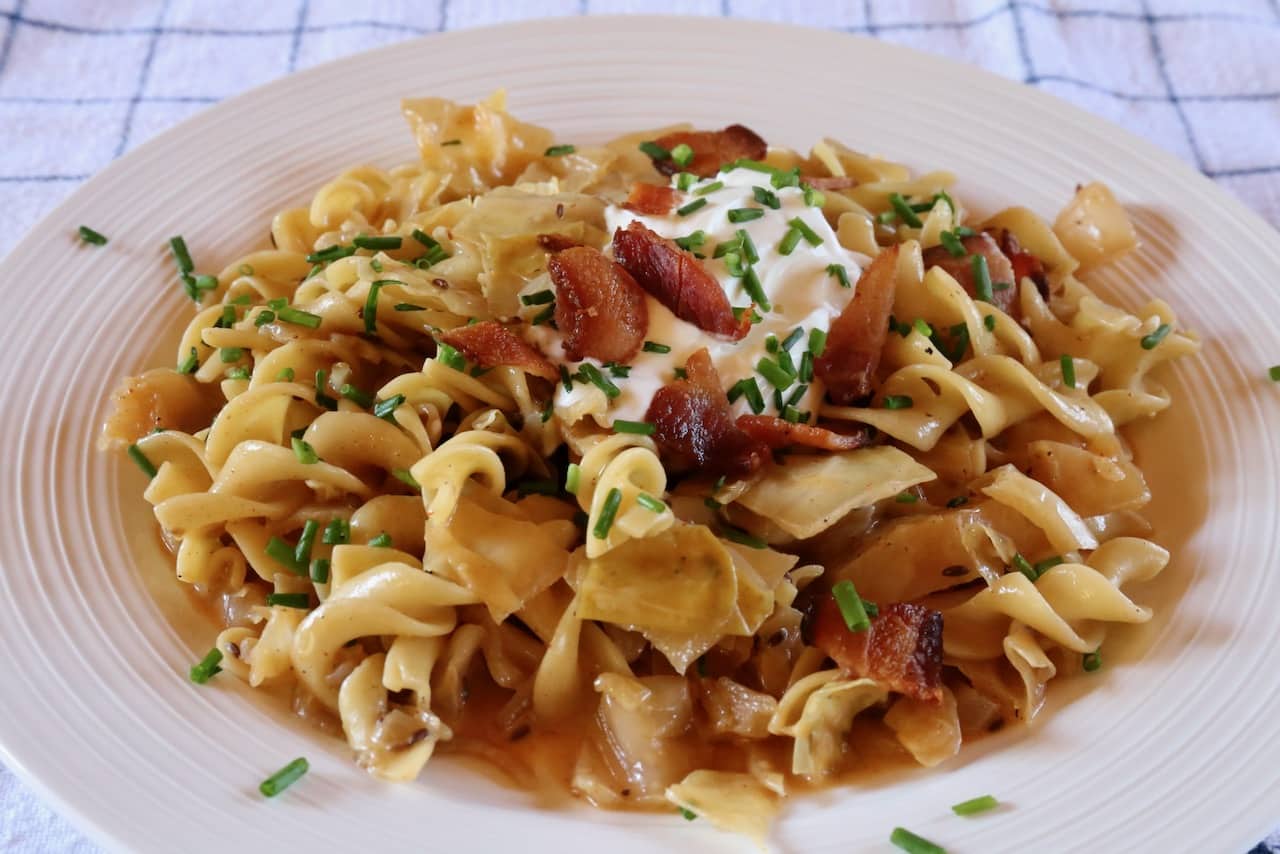Vietnamese Egg Rolls, also known as Cha Gio, are crunchy and chewy, stuffed with pork and shrimp and slathered in sweet and spicy dipping sauce.
Looking to learn how to make the best recipe for homemade Vietnamese Egg Rolls?
Our step by step recipe for the popular Vietnamese appetizer teaches you how to make an easy shrimp and pork filling. When then offer a video tutorial on how to fold and wrap egg rolls, as well as tips on what to serve with these yummy crispy deep fried snacks.
Save this story to Pinterest!
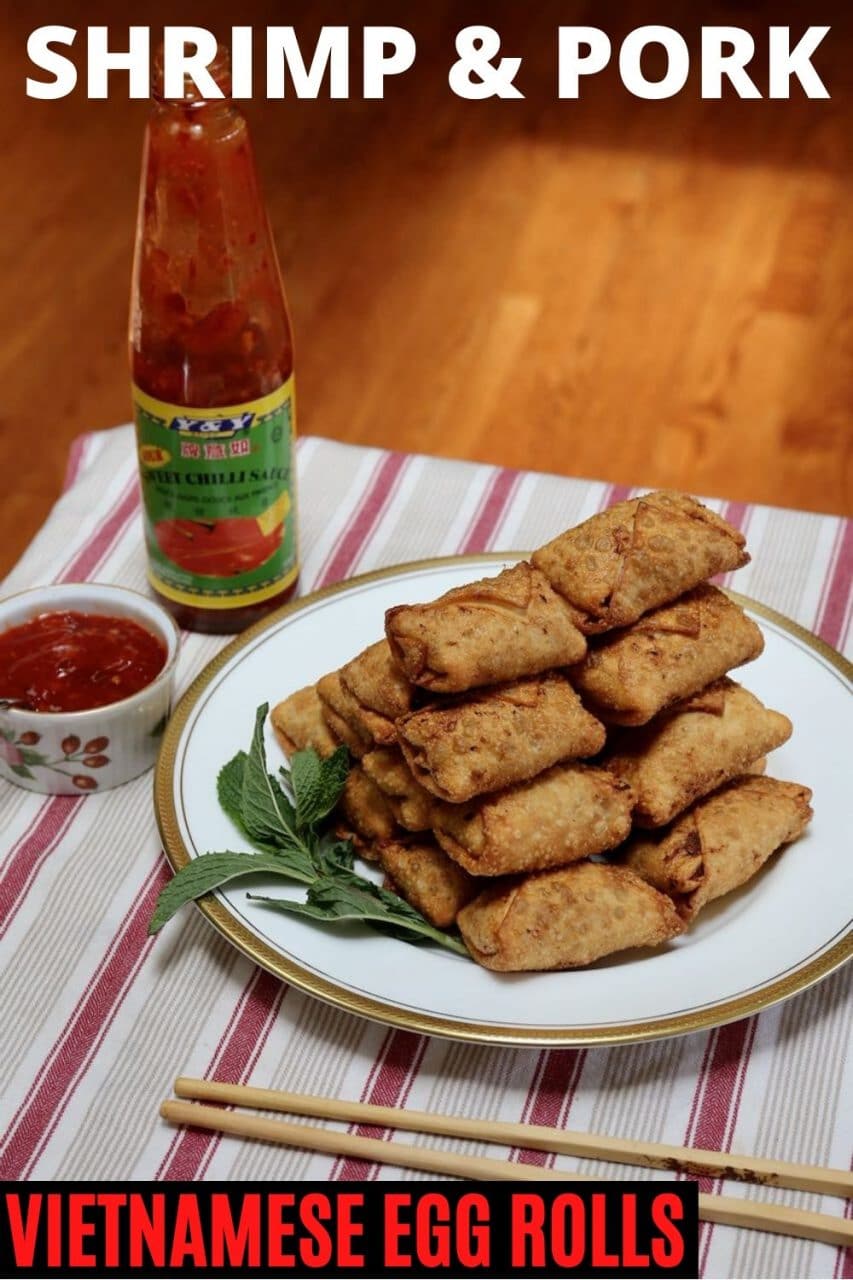
Travel to Vietnam by Cooking Vietnamese Egg Rolls at Home
I love traveling to Asia. My first visit to the region had me living in South Korea for a year as a teacher and it’s where I was first introduced to fermented vegetables like kimchi.
After my contract ended in Seoul I travelled throughout southeast Asia for 6 months, visiting the Philippines, Indonesia, Malaysia, Singapore, Cambodia, Laos, Myanmar, Thailand and Vietnam.
I spent over a month traveling by bus through Vietnam. I started in the south, spending a few days in Saigon before exploring the floating markets in the nearby Mekong Delta. I then took a series of night buses north making stops in Nha Trang, Hoi An, Hue, Halong Bay and Hanoi.
What I found most fascinating is Vietnam’s distinct regional food cultures. Much like the regional cuisines found in France, Germany, Italy or Spain, each town in Vietnam had its own local speciality.

Where To Eat Vietnamese Egg Rolls
If you live in a large city in Canada or America you’ll likely have access to a local Vietnamese restaurant that serves traditional Vietnamese Egg Rolls.
Haven’t traveled to Vietnam before? It may be helpful to first sample Vietnamese Egg Rolls at a local restaurant to better understand how the dish is served. You can also assess the thickness and size of the egg rolls and sample the correct texture and flavour of the filling before trying to make them at home from scratch.
In Toronto, popular Vietnamese restaurants that may serve Vietnamese Egg Rolls include Pinky’s Ca Phe, Pho Phuong, Pho Vistro, Anh Dao, Pho Hung, Pho Asia 21 or The Golden Turtle.

History of Vietnamese Egg Rolls
Vietnamese Egg Rolls, also known as Cha Gio, are similar to Chinese egg rolls so it is assumed the recipe traveled into the country via the northern border thanks to ancient traders.
After spending centuries under the rule of China, the country had undeniably influenced Vietnamese cooking. Such is evident with the use of chopsticks, the art of stir-frying, noodle-rich recipes, and the use of bean curd. The almost one hundred years of colonization by the French also played a central role in the development of Vietnam’s cuisine.
Techniques like sautéing is adopted along with the fascination for baguettes, café au lait, and gateaux. While Chinese influences are seen stronger in the north, people’s adaptation of more French-inclined cuisine is more common in the south.
Considered one of Vietnam’s national dishes today, Cha Gio is said to be originally made for royalty, which is how it got one of its nicknames “imperial rolls”. The concept of combining vegetables, seafood, meat and wrappers into one decadent deep fried roll was intended to delight the royal court while at the same time serving as a mouth-watering meal that maintains a good balance of both yin and yang.
There isn’t a strong written history about Cha Gio and if you try to trace its original roots from both ends of Vietnam, you’ll find they even call the dish by different names. Southern Vietnam calls it Cha Gio while communities in the north call them Nem Ran or simply Nem.
The taste and preparation method for Vietnamese Egg Rolls is totally different from the Chinese version. Filled with fresh seafood, plump pork and fragrant vegetables, the crispy rolls are wrapped and deep fried in thin dough until golden and crispy. The rolls are typically served with Vietnam’s ubiquitous nuoc cham dipping sauce.
Served either as a light snack or appetizer, these savoury smelling and delicious packages of goodness may be known to locals as holiday treats, but they can easily be served any day of the week.
Cha Gio can be referenced by several names such as crispy spring rolls, summer rolls, egg rolls and imperial rolls. However, many Vietnamese cooks would argue the closest and most accurate name to describe the popular deep fried appetizer is simply Vietnamese fried egg rolls.

What Is the Difference Between Egg Rolls and Spring Rolls?
The main difference between a spring roll and egg roll is that spring rolls have thin, often translucent flour wrappers and usually aren’t fried, while egg rolls have thicker, deep-fried wrappings.
Begin by inspecting the two deep fried rolls to look for a unique visual distinction. This may be the largest difference between the two. An egg roll’s surface is covered in small bubbles and a spring roll’s surface is perfectly smooth.
Then there’s the matter of mouth feel—at first bite, an egg roll crunches and is a little chewy while the outside of most spring rolls will shatter into several thin flecks of light and crispy dough as soon as your teeth crack through the surface.
The dough for egg rolls is made of flour and eggs, giving it a sturdier texture and making it more like fried pasta. The dough is rolled to be a little thicker than a spring roll, and after it’s filled and wrapped, the entire roll is deep fried.
Spring roll dough contains no egg, making it lighter and crispier than the egg roll when fried. Since variations of the dish have been made across thousands of miles in Asia over the span of centuries, there are numerous fillings and methods used to create the ever-diverse spring roll.
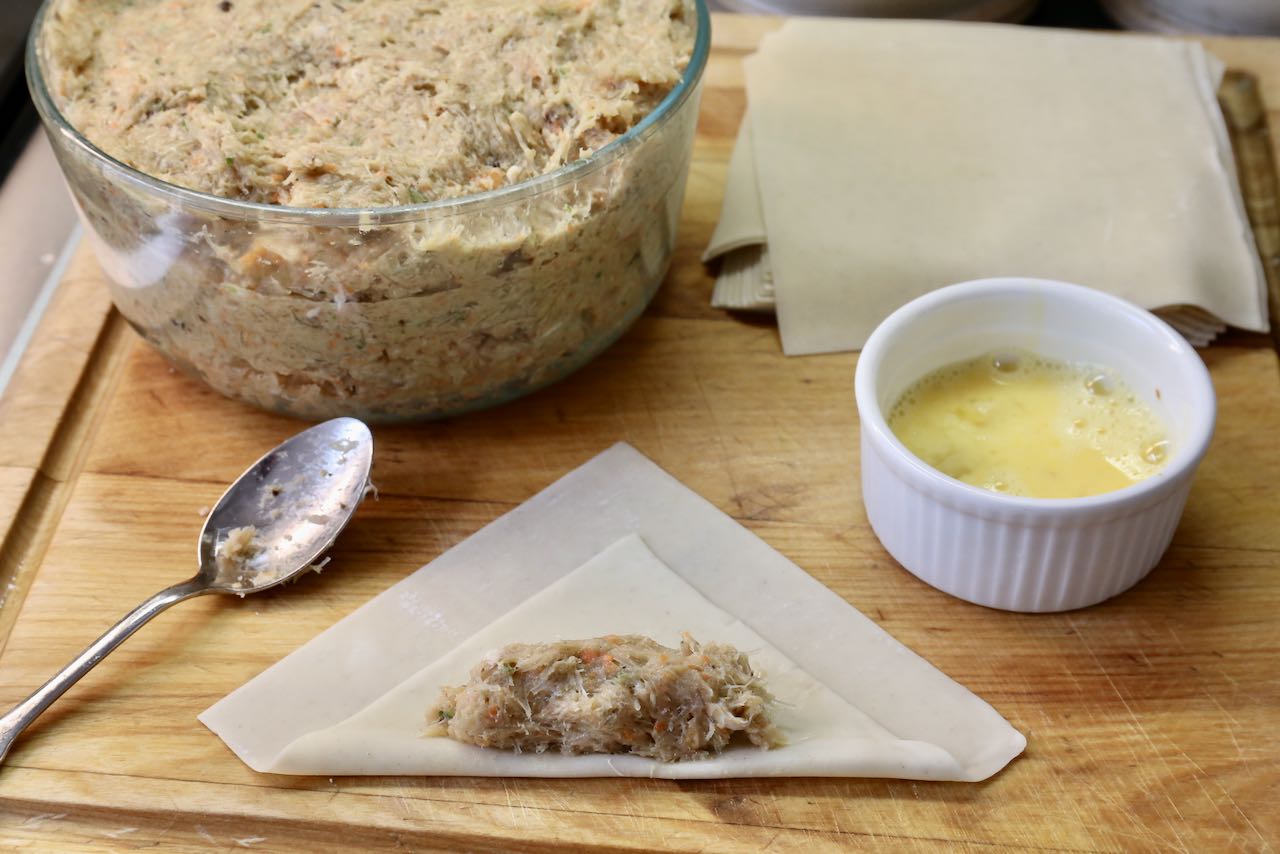
My Family Loves Vietnamese Egg Rolls
Whenever my family would order takeout or delivery from a local Canadian Chinese or Vietnamese restaurant we’d always order egg rolls or spring rolls.
Vietnamese egg rolls are the perfect compliment to spicy lemongrass pork chops, rice noodle stir fry or sautéed vegetables with fish sauce and fresh herbs. Egg rolls offer the perfect chewy crunch that contrasts nicely with other popular Vietnamese dishes.
After living in Asia for two years I developed a love affair for each countries unique take on deep fried rolls. I enjoyed crunchy spring rolls at Michelin starred restaurants in Hong Kong, a massive bean sprout stuffed variety paired with a plate of Pad Thai in Bangkok and massive Vietnamese Egg Rolls the size of a babies arm on a scuba diving excursion in Nha Trang.
I returned to Toronto with a newfound appreciation for the diversity of these addictive and petite parcels. My favourite are Vietnamese Egg Rolls as I love the filling combination of shrimp, pork and mushroom. Dipping each crunchy egg roll into Vietnamese nuoc cham or Thai chili sauce is a sublime snack!

How To Fold & Wrap Egg Rolls
There are an endless number of ways to wrap and fold Vietnamese egg rolls. Families tend to pass down their preferred method so as long as your filling is tightly wrapped you’re good to go.
There are two common ways to fold and wrap egg rolls, which depend on how large your egg roll dough sheets are in size. If you have extra large egg roll wrappers you can use the method below, which involves placing the stuffing in the centre of the wrapper, folding upward halfway, folding inwards to tuck in the sides and then sealing with egg wash.
If you are working with smaller wrappers, like we did for this recipe, you can check out our method in the picture above. We started by folding the bottom of the wrapper two thirds the way up. This creates approximately an inch of space between the filling and farthest reaches of the wrapping. This helps ensure the Vietnamese Egg Roll won’t explode when dropped in hot oil.
Begin by placing approximately 1 heaping tablespoon of Vietnamese Spring Roll filling onto the centre of the fold. Then fold the two sides inwards and tightly roll the filling upwards. Before finalizing the tightly wrapped package add egg wash to the top of the dough to help seal it with the flap. The mini Vietnamese egg rolls should appear like small envelopes.
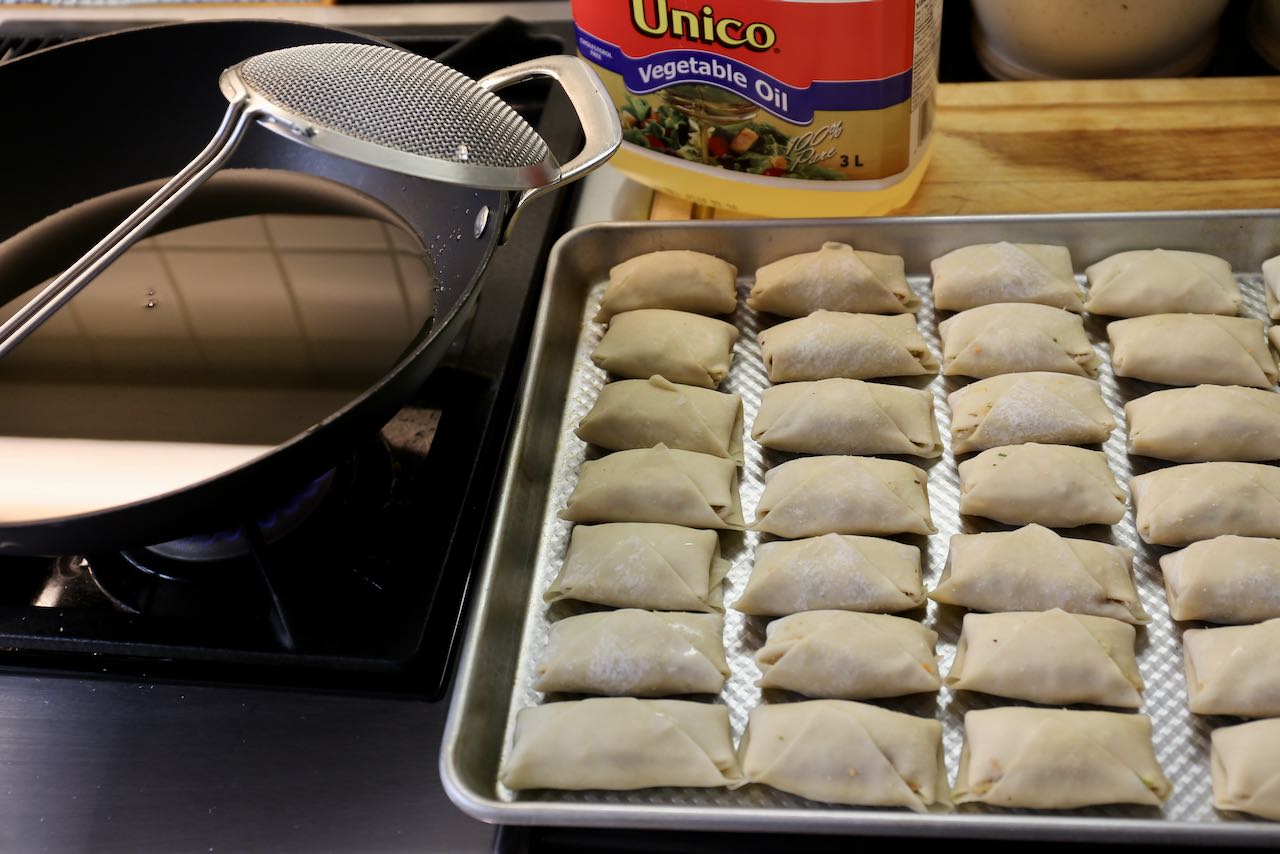
Tips For Making Egg Rolls
Since making homemade Vietnamese Egg Rolls is a labour of love (read: slightly time consuming) we suggest starting the process at least 3 hours before you want to eat. This gives you plenty of time to take breaks between the various preparation steps if you have a busy day ahead.
You can cut down on prep time if you have one or two helpers in the kitchen who can assist you in wrapping and folding your egg rolls. In Vietnamese families, egg rolls are typically folded by hand and enjoyed as a social experience shared between grandmother, mother and daughters.
If you’ve got a family with curious kids who want to learn how to cook, folding and wrapping egg rolls is a safe and easy way to have fun in the kitchen. Leave the knife work, food processor and deep frying to mom or dad. Kids love stuffing wrappers with filling, folding them into pretty packages and wiping them with egg wash!
You can easily organize your prep and cooking into three distinct stages: preparing the filling, wrapping the egg rolls and deep frying. If you’re hosting a large dinner we suggest preparing the filling a day or two in advance. Simply store it in the fridge until the day of your party.
Most recipes for Vietnamese Egg Rolls suggest mixing the filling by hand. If you’re a little lazy on your finely chopped or julienned vegetable skills are lacking we suggest blending all the ingredients in a food processor. It saves a lot of time and ensure the finished mixture is a fully combined paste.
When you’re ready to wrap and fold your egg rolls, turn on your favourite show on Netflix or blast your favourite music. It’s important to set yourself up to be entertained as once you get folding your fingers get sticky with filling and egg wash.
Set your wrapping station up on a clean space on your kitchen counter. We suggest placing a baking sheet to your left to place the finished rolls, the bowl filled with filling to your right and a stack of wrappers and small ramekin filled with beaten egg in front of you. Once you’ve perfected the first few Vietnamese Egg Rolls you’ll find a pace and rhythm and they’ll be done in no time!
Each finished egg roll should be placed on a clean baking sheet so you can easily drop them into your wok or deep fryer. If you have a professional kitchen thermometer, heat up your vegetable oil until it reaches approximately 350 F. If you don’t have a thermometer you can test the oil to ensure it’s hot enough by dropping a piece of bread in the oil. You want to drop your spring rolls into the oil once it immediately bubbles.
Be sure to have your feet firmly planted in front of the stove when deep frying. Wear an apron, covered shoes and pants to protect yourself from a potential burn in case any oil splatters up at you. Vietnamese Spring Rolls typically take around 3-4 minutes to cook. You’ll know they’re done once the surface of the spring roll is golden brown and bubbly.
If you’re planning on consuming all of your spring rolls that day, cook them until they are ready to eat. If I know half of the egg rolls are going in the freezer to be enjoyed later I’ll remove them one or two minutes early. This ensures that when you reheat them in the oven later they do not dry out and overcook.
If you’re having a small group for dinner we suggest setting your table with salads and a noodle dish or curry before heating your wok. All of your guests should be seated at the table when you first drop the Vietnamese egg rolls in oil as they will be ready to eat in under 5 minutes.
If you are having a very large group for a Christmas Party, Mother’s Day or a birthday, you can deep fry the egg rolls in advance and take them out a minute or two before they are done. Simply store them in the fridge on a baking sheet and place them in the oven to reheat them 10 minutes before serving.
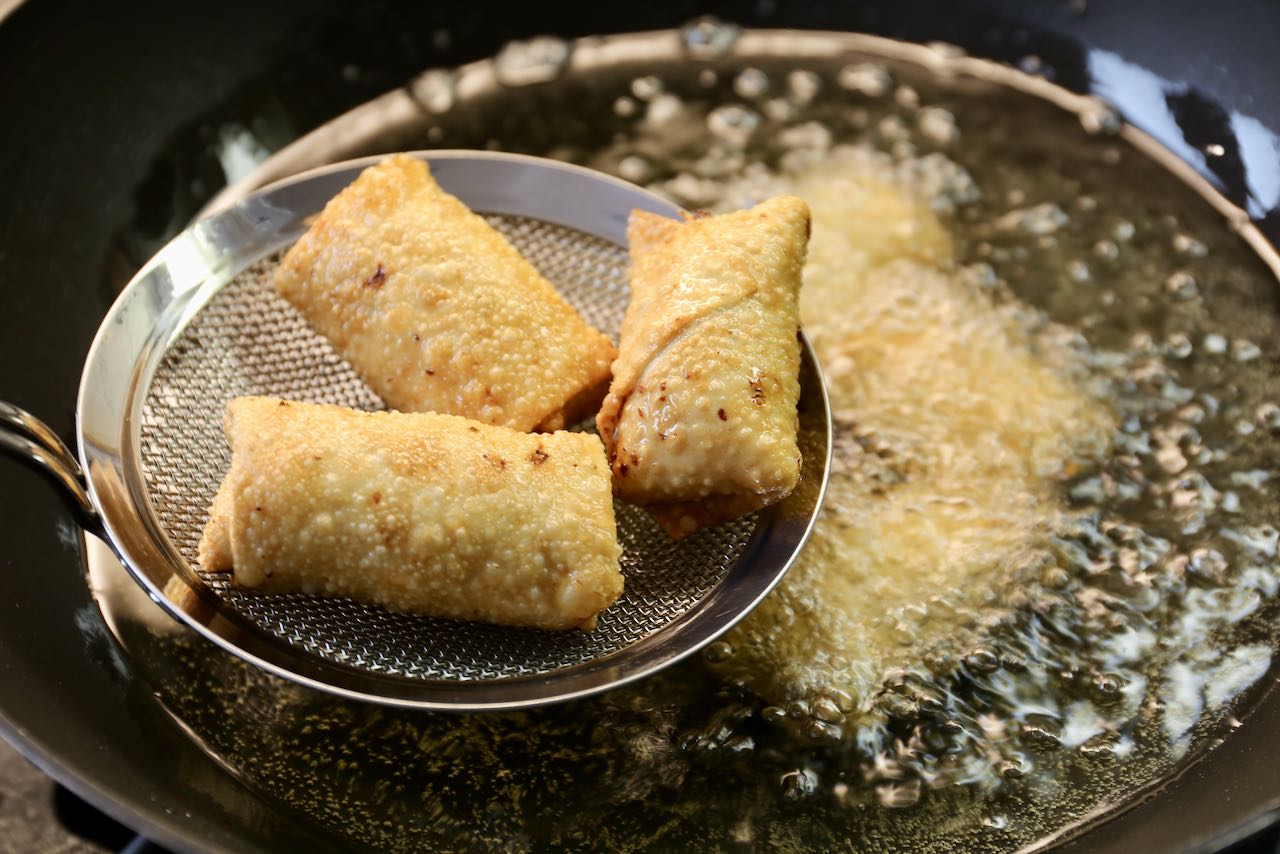
What To Serve With Egg Rolls
Egg rolls are best served shortly after they have been deep fried. Ensure they have rested on paper towel for a minute so your guests don’t get greasy fingers or burn the inside of their mouthes.
Sometimes I like to just enjoy 5 or 6 egg rolls as a snack or light lunch. They’re a perfect last minute meal idea when you’re faced with a busy week.
If you’re hosting a dinner party and need to flush out a more well balanced meal, think of the egg rolls as your crunchy and crispy contribution. It should also be the only deep fried item on the menu, so look to contrast Vietnamese egg rolls with fresh, juicy and acidic salads.
We love to serve Vietnamese Egg Rolls with homemade beef brisket pho noodle soup. They also pair nicely with Thai Beef & Pumpkin Curry, Vegetarian Shahi Paneer or Vietnamese Crepe Bánh Xèo.
No egg roll should be enjoyed naked all on its own. The reason we love Vietnamese Egg Rolls so much is because the fragrant filling pairs so perfectly with quality dipping sauce. Traditionally egg rolls in Vietnam are served with a dish of nuoc cham. You can also enjoy these deep fried rolls dipped in Thai sweet chili, sweet and sour sauce, plum sauce or a more simple hoisen or soya sauce.
How To Store Egg Rolls
This recipe makes a large quantity of of Vietnamese Egg Rolls. Depending on how large your wrappers are, you may have some leftover filling, which we suggest storing in an airtight container in your freezer to stuff and wrap later.
Since we used smaller egg roll wrappers in this recipe, we were able to make 60 mini Vietnamese egg rolls with approximately 1 cup of leftover filling. If you’re using larger wrappers this recipe will likely make 40-50 plump rolls. The yield of this recipe also depends on how generous you are with your filling.
Since the process of making homemade egg rolls is time consuming, we alway try and make a bit extra so we can enjoy them later for lunch or dinner.
We suggest deep frying all of the egg rolls from this recipe and storing any leftovers in the fridge or freezer. Do not place uncooked leftover egg rolls in the freezer as they will be mushy when thawed. It is recommended to store fully cooked egg rolls in a ziplock bag or airtight container in your freezer.
They keep for up to 3 months in the freezer and make for a quick and easy last minute meal. Simply remove the number of cooked egg rolls you want to eat out of the freezer and place on a baking sheet and reheat at a 400 F oven for 20-25 minutes.
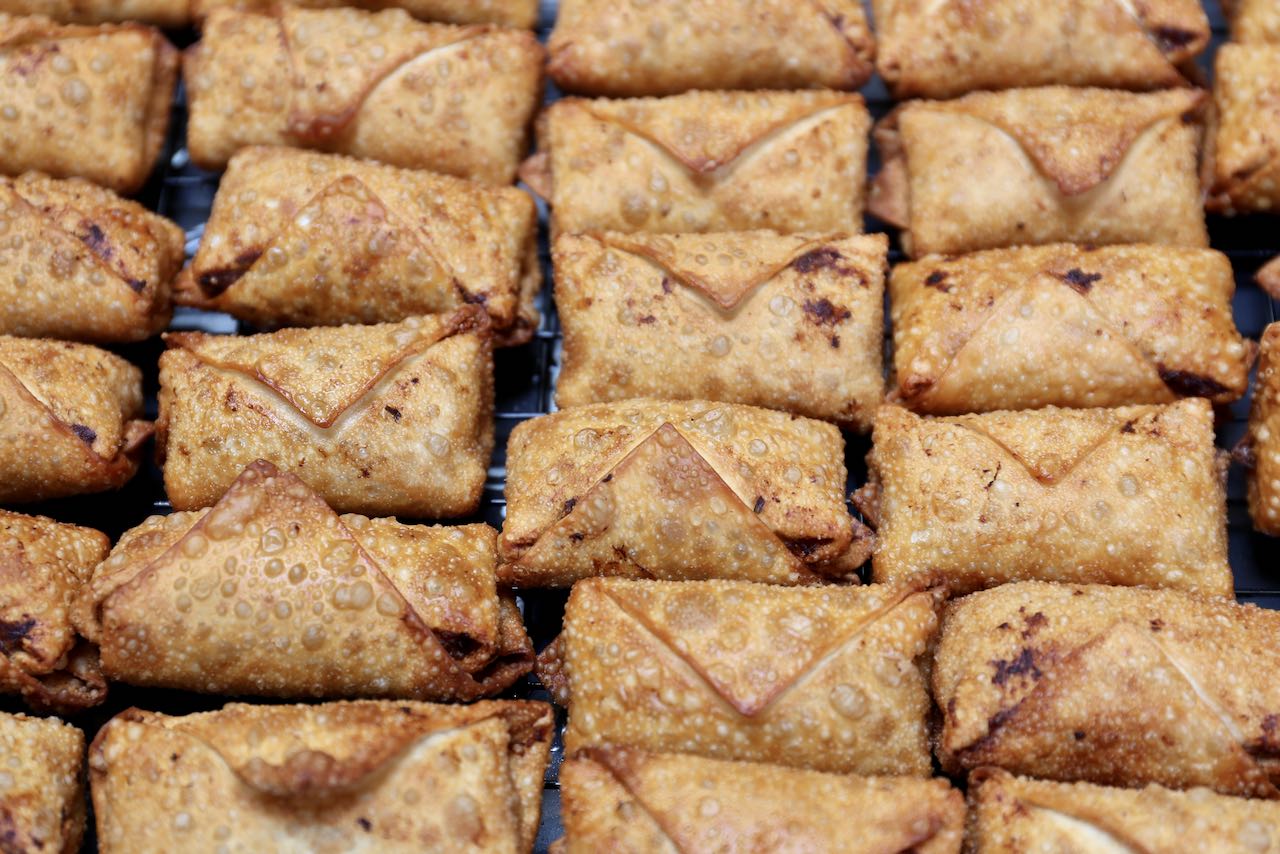
You May Also Enjoy Reading…
- Easy Homemade Thai Beef and Pumpkin Curry
- Best Homemade Baked Korean Gochujang Chicken Wings
- How To Make Easy Vegan Chinese Cucumber Salad
- How To Make Spicy Tikka Masala Turkey Barley Soup
- How To Make Italian Dumplings: 3 Easy Ricotta Gnocchi Recipes
- How To Make Velveeta Cheese Dip: Best Mexican Queso Recipes
- How To Make Homemade Pierogies
- How To Make Tartiflette Reblochon
- Sweet and Sour Pork Meatball Recipe
- Peanut and Sesame Noodle Bowl with Korean BBQ Pork and Pickles
- How to Make Crispy and Healthy Oven Baked Sweet Potato Fries
- Best Vegetarian Shahi Paneer Recipe
- Best Homemade Cheese Bacon Muffins
- Indian Crepes: How To Make Vegan Pudla
- Best Homemade Keto Brussels Sprouts with Bacon Recipe
- How To Make Vietnamese Crepe Bánh Xèo
- Best Sourdough Discard Recipes
- Best Homemade Keto Spinach Dip Recipe

Best Vietnamese Egg Rolls
Vietnamese Egg Rolls
Equipment
- Mixing bowls
- measuring spoons
- measuring cups
- Food processor
- baking sheet
- Metal strainer
- Wok
Ingredients
- 0.5 lb ground pork
- 0.5 lb shrimp chopped
- 1/4 cup dried mushrooms
- 2 oz dried bean thread vermicelli cellophane noodles
- 0.5 carrot sliced
- 1 green onion
- 0.5 onion minced
- 1 tbsp white sugar
- 1/8 tsp black pepper
- 1/8 tsp Kosher salt
- 2 tbsp oyster sauce
- 1 egg beaten
- 30 Egg roll wrappers
Instructions
- In a medium bowl, mix together ground pork, chopped shrimp, rehydrated dried mushroom, vermicelli noodles, green onions, carrot, onion, sugar, black pepper, salt and oyster sauce. Set aside.
- Separate egg roll wrappers into individual sheets by pulling them apart slowly to prevent tearing.
- Use about 2 tablespoons of filling for each egg roll. WRAP
- In a wok, heat vegetable oil until sizzling. Fry in small batches for 2-3 minutes or until egg rolls are golden brown. Transfer egg rolls onto a wired rack to drain off excess oil.
- Serve immediately with nuoc cham, plum sauce, Thai sweet chili sauce or Sweet & Sour sauce. Leftover egg rolls can be frozen and deep-fried straight from the freezer. Frozen egg rolls take about 6-7 minutes to cook.
Nutrition
Some of the links in this story use affiliate links. This means that if you make a purchase through our site, Dobbernationloves will earn a small commission at no extra cost to you. Your support helps us to produce comprehensive content.
Save this story to Pinterest!


